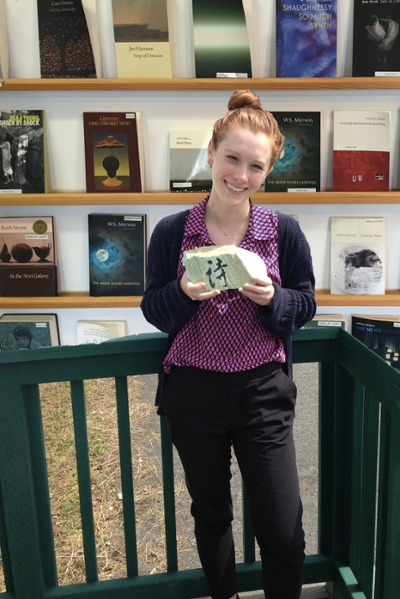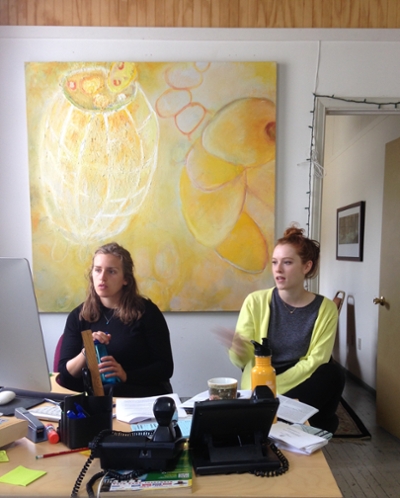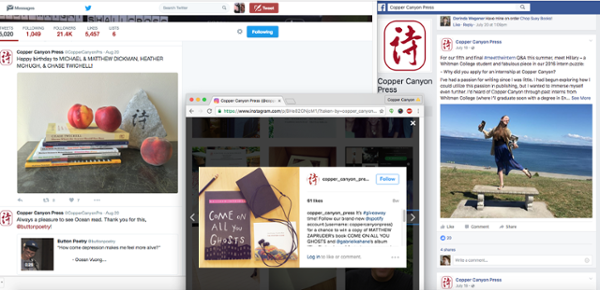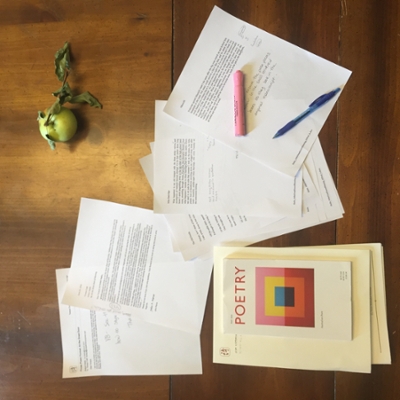Summer Internship Award: The Business of Art

A photo collage of me on the front porch of Copper Canyon holding a rock with the logo on it, in front of a wall of our books
When I started as a production intern at Copper Canyon Press—which is probably the most acclaimed, completely independent, nonprofit publisher of poetry in the US—I wasn’t sure what I’d be doing. The staff told me that I had been selected to take on more responsibilities in the department of PRODUCTION, but I didn’t know exactly what that would entail. What I came to realize is that, although I had some specialized tasks, Copper Canyon overall offers one of the most holistic publishing internships. Unlike interning for one of the “Big Five Publishers” (conglomerates like HarperCollins, Penguin Random House, and MacMillian), where one would have to specialize in a specific department, interns at an independent publisher like Copper Canyon receive hands-on experience in all departments.
I, like many young people interested in books, thought that the most important step was in editorial, that most of the exciting work of poetry publishing happened during intimate work with author and language. And my assumption makes sense: I came directly from completing a Reed research thesis on poetry. Most of my immediate experience with poetry was as someone who engages intellectually with the text. But this isn’t what publishing is all about.
One of the key concepts I learned was from our co-publisher and marketing head when he said, “to publish is to make public.” I had been thinking about poetry as a private, rigorous process of interpretation; but what publishing is all about is making literary art public. To make public entails reconceptualizing the book as both a product entering a market and as an artwork that enters a social and cultural network. The truth is, books, even poetry books, need to make money, or the company (or nonprofit) just isn’t feasible. Copper Canyon books are products that require marketing and publicity, but they simultaneously are works of art that create community among those who share them.
Once I began thinking about making books as products to be made public, the work of production made more sense. Production is like the fulcrum between two sides: the manuscript as pure art and the shareable product. The conceptual choices made in the editorial department informs the work in production, which brings the book to life in terms of contracts, formatting, copyediting (and more editing), designing, and printing. Most of

production takes place on scribbles, emails, and phone calls, where the managing editor has meaningful conversation with the author in order to share their work in its best form. These artistic collaborations/business partnerships allow for the trust that help a book form, in the littlest details from fact checking, to trim size, to typeface.
All of these conversations, relations, and (sometimes tedious) work of crafting the bones of the book lead to the final product. From there, production helps influence the ways in which the book is shared with the public. Personally, it was exciting to see the ways that production majorly impacts digital PR and social media presences. As a young consumer of books from all different presses, one of my favorite ways to interact with publishers, authors, and literary institutions is by following them on Twitter, Facebook, and Instagram.Many steps of the production process can influence copywriting or even be shared on social media, directly promoting the book, the press, and the author. And happily, at my Copper Canyon Internship, I go to work on projects in production and digital PR, fueling my love for the ways they intermingle. Different digital presences can be immediately shared together, hopefully driving sales and awareness, and just sharing some good books, which ultimately is what brought me here.

Tags: summer internship award

